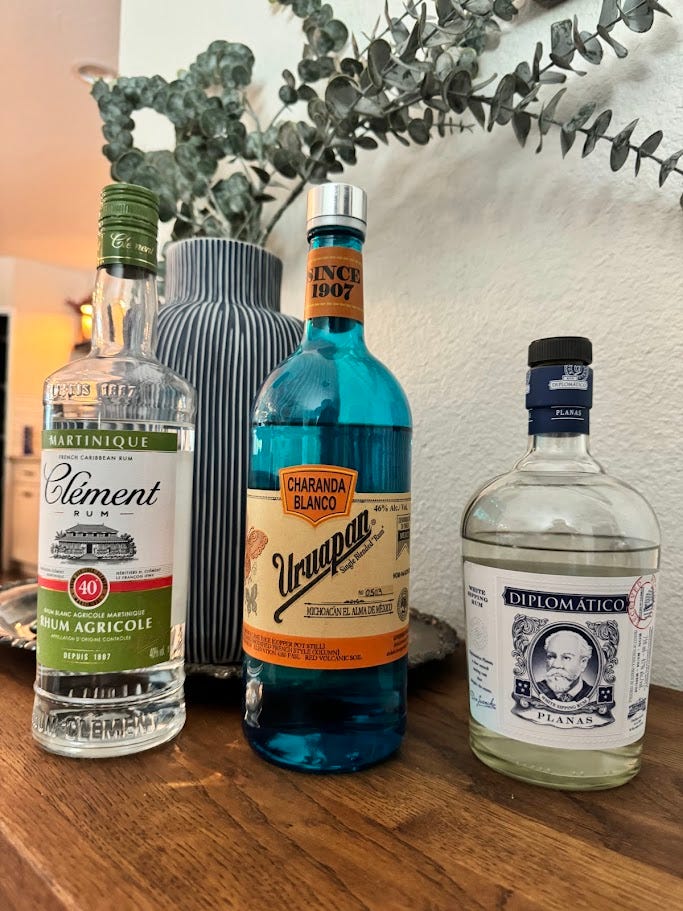Choosing a White Rum for the House Daiquiri
Which is tough, since White Rum isn't a real category...
I think I drank my first “classic” Daiquiri in 2014. I don’t remember where, but I remember it being a seminal moment. One of the first times I realized that lots of cocktails had a history beyond the big umbrella drinks, and probably one of the reasons I got interested enough to start writing about them several years later.
And while I’ve loved Daiquiris since then, I haven’t made many. And I’ve never written about them. Which feels weird. So let’s change that.
Daiquiri Overview
The most classic Daiquiri is the one found in the OG cocktail book The Fine Art of Mixing Drinks. It specifies 8 parts of white rum, 2 parts of fresh lime juice, and 1 part simple syrup shaken with ice and served neat. That’s more than double the amount of rum as the mixer, which is STRONG. Most recipes you see these days is closer to equal amounts of rum and the mix, which is the more classic sour ratio. It’s a very simple, three-ingredient drink that really rests on the white rum. Which becomes complicated when you realize that white rum isn’t real.
White Rum…?
I can’t possibly do any better here than the absolute expert Matt Pietrek who writes the amazing Rum Wonk newsletter:
TL;DR - White Rum just means a sugar-based distilled spirit that happens to be (mostly) clear and it can effectively taste like anything. So, if you go to the rum section of your local liquor store and essentially pick any bottle that’s clear at random and make a Daiquiri, you will make a drastically different drink than the next person who walks in and does the same thing. That means that picking the white rum for a Daiquiri is the most important piece of the puzzle, even more than the ratio you use in the drink.
My “White Rum” Options
I basically went to my local liquor store and bought 3 random bottles of clear liquid from the rum section. But, I was careful to select 3 different concepts of “white rum” to see which works the best in the most classic rum cocktail going. Let’s dive in.
Clement Rhum Agricole
From Martinique, this rum (Rhum, given the origin - it’s a whole thing and I’m not gonna get into it) is an Agricole, a style frequently found in the former French colonies of the Caribbean. Agricole is distilled from the juice of sugar cane, making it very similar in process to a vodka (directly distilling the product of nature) than most other rums which are distilled from molasses (which has already been processed in its own right).
Where it’s not similar to a vodka in any way, shape, or form is the taste. Here, to me, Agricole is most similar to grappa. There’s some terroir happening here, and there’s a lot of funk to go with it. Clement calls this expression out as “approachable and highly mixable” and it’s aged exclusively in stainless steel (so the clear color is legit). That “unaged cane juice” highlight is the most basic way to think of an Agricole.
This has a very grassy, musky nose which makes sense given the pure sugarcane mash bill. The palate is clean and crisp without much sugar coming through, but the grassy notes stick around as well. On its own, I enjoy this but worry it might be both a bit too funky and a bit too light to carry a daiquiri.
Uruapan Charanda Blanco
If “rhum” threw you off, just wait for charanda! This is essentially “Central-Mexican rum” and this expression from Uruapan is effectively halfway between an Agricole and a more “standard” rum. That’s because this is bottle is exactly 50% sugarcane distillate from the estate and 50% molasses distillate. I was drawn to it since Arizona has much more in common with central Mexican ecology than the standard Caribbean island/coast. The brand doesn’t say how it’s aged, but I think the clear color is legit here as well; I don’t get any wood anywhere.
The nose is deep and toasty, which makes sense given the molasses content. But because there’s cane there too, you can still smell a bit of grass. That grass comes through strong on the palate, but then the finish gives way to the roasty molasses notes. There’s some red fruit on the finish as well which is really nice. I like it a lot, but I worry that this might be too much body to work in a standard sour cocktail.
Diplomatico Planas
Diplo is Venezuelan, and I’ve liked their aged expressions for a long time. You’d think, since this juice is clear, that it is an unaged expression just like the previous 2 clear-liquid bottles. Unfortunately, you’d be wrong.
It’s not that Diplo tries to hide this - they call it out as “aged white rum” - it’s just that we don’t associate clear spirits with “aging.” And in rum that’s not necessarily a safe assumption. That’s because it’s common practice to age a rum in wood and then filter out the color (usually using charcoal filtration) so that the juice is clear again. The brands that do this don’t hide that it’s aged, but they do tend to hide for how long it was aged. As best I can tell, no one knows how long Planas is in a barrel.
Regardless, you can taste the wood here. The nose is oaky and boozy, and it has a more substantial mouthfeel. I get a lot of coconut on the palate, giving the drink a very tropical feel overall. It’s quite sweet but burns quite hot, so there’s a decent balance. In a lot of ways, this is what my brain thinks when I see “rum” and I’m positive it will pair great in cocktails.



